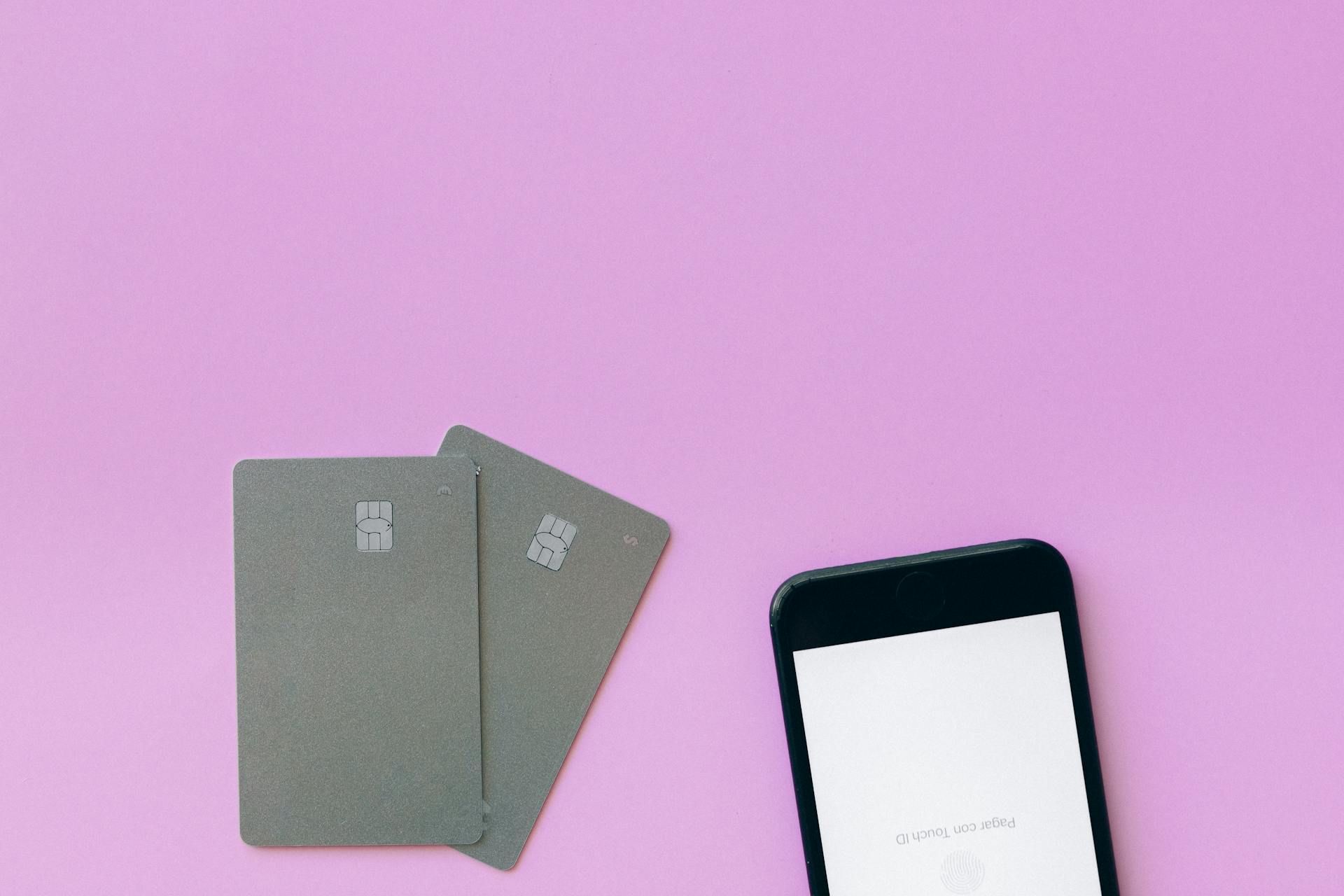
Living with high debt can be overwhelming, but taking control of your finances is possible. According to the National Foundation for Credit Counseling, 77% of Americans carry credit card debt.
It's essential to understand that credit cards can be both a blessing and a curse. If used responsibly, they can provide a convenient way to make purchases and earn rewards. However, if not managed correctly, they can lead to a cycle of debt that's difficult to escape.
To take control of your finances, it's crucial to face your debt head-on. This means creating a budget, tracking your expenses, and making a plan to pay off your debt.
Debt Management Strategies
Having a solid debt management strategy is key to paying off credit card debt. Consider finding a payment strategy or two to help you stay on track.
You can also think about a debt management plan, which is created with the help of a credit counseling agency. They'll negotiate new terms with your creditors and consolidate your credit card debt.
Comparing debt payoff strategies can help you find the best approach for your situation. Research and compare different strategies, such as the avalanche method and the snowball method.
The avalanche method involves making minimum payments on all your debts but putting extra money toward the debt with the highest interest rate. Once that debt is paid off, you can move on to the next-highest rate.
The snowball method is similar, but focuses on putting extra money toward the debt with the lowest balance first. This might be easier to stick with, especially if you can cross debts off your list sooner.
A balance transfer credit card can also be a good option, especially if your credit is in good shape. You can transfer balances to the card from your other credit cards, but make sure to have a plan for paying off the balance in full by the end of the offer's introductory period.
A debt consolidation loan is another possibility, where you can use the loan to pay off the credit card debt. This can make managing your finances easier and save you money on interest payments.
Readers also liked: Balance Transfer Credit Cards with High Credit Limits
Here are some debt payoff strategies to consider:
It's worth taking the time to understand your potential options and find the best strategy for your situation.
Payment Planning
To tackle high debt, you need a solid payment plan in place. This involves understanding how much you're earning and how much you're spending. You can use a budgeting method that you follow closely each month, or prioritize credit card payoff by sending a fixed amount to your debt first.
Making more than the minimum payment is a good starting point. You can use a calculator to see how much faster you could pay off your debt if you send an extra $25, $50 or more to your balance each month. This will reduce your principal balance and the interest you pay.
Automating your payments is a great way to ensure you never miss a payment. You can set up a recurring automatic payment for a fixed amount per month, which can take into account all the changes you've made to your budget and the money you've decided to redirect to credit card payoff.
Recommended read: Navy Federal Platinum Credit Card Balance Transfer
To further reduce interest, consider making two payments each month. If you're currently paying $50 a month, try doubling it to $100, and try to make a payment each time you get a paycheck. This can also help strengthen your credit score.
You can also use a credit card payoff calculator to find out how long it might take you to pay off your credit cards. By changing the monthly payment amount, you can see how increasing your payment can affect how much interest you pay and how long it takes to pay off your cards.
Here are some key payment planning strategies to keep in mind:
- Paying more than the minimum payment reduces your principal balance and the interest you pay.
- Automating your payments ensures you never miss a payment.
- Making two payments each month can reduce interest and strengthen your credit score.
- Using a credit card payoff calculator helps you understand how long it might take to pay off your credit cards.
Reducing Debt
Reducing debt can be a daunting task, but there are several approaches you can take to make it more manageable. The debt snowball method is one popular approach that prioritizes debts by amount, focusing on the smallest balance first.
You can also consider the avalanche method, which prioritizes debts by interest rate, focusing on the card with the highest interest rate first. This approach can save you more money in interest over time.
Worth a look: What Is a High Interest Rate on Credit Cards
Another option is to consolidate your credit card debt by opening a new credit card with a 0% intro APR offer or taking advantage of balance transfer offers. This can save you money on interest and make it easier to pay off your debt.
To make a balance transfer, you'll need to move your debt from a high-interest card to one that offers a promotional 0% APR period, typically 12 to 21 months. This can lead to big savings, such as paying $0 in interest on a $5,000 balance.
Here are some steps to consider when reducing debt:
- Make a list of each debt you have and its interest rate.
- Identify areas where you can cut back on spending to put more money towards your debt payment.
- Consider using the debt snowball method or the avalanche method to prioritize your debts.
- Look into 0% balance transfer credit cards to save money on interest.
- Consider taking out a fixed-rate debt consolidation loan to pay off your debt.
Remember, reducing debt takes time and effort, but it's worth it in the long run. By making small changes to your spending habits and debt repayment strategy, you can make progress towards becoming debt-free.
Understanding Debt
Knowing where you stand financially is key to creating a realistic debt repayment plan. You can start by listing your loan and credit card account details, including the current balance, minimum monthly payment, and interest rate for each account.
To get a clear picture of your financial situation, you'll also want to figure out your take-home pay, including how much you take home after taxes and withholdings for employee benefits.
Calculating your necessary expenses is also crucial, as it will help you determine how much you need to spend each month on necessities like home expenses, utilities, gas, and food. This includes prorated amounts for irregular expenses like insurance premiums.
Here's a breakdown of the essential expenses you should consider:
By understanding your debt and expenses, you'll be better equipped to develop a plan to pay off your credit card balances and get back on track financially.
Consider Why You're
Understanding why you're in debt is crucial to finding the right debt-payoff strategy. It's like trying to fix a leaky pipe without knowing where the leak is coming from - you might patch it up, but the problem will still persist.
A limited-time emergency can be a common reason for credit card debt. You might have used credit cards as a stopgap when you were out of work or had a large unexpected bill, but now you're back on your feet and can focus on paying off the debt.
If you're in debt due to a lack of income, it might be more productive to focus on increasing your earnings or finding ways to save money on necessities. This could involve getting a side job, cutting back on expenses, or finding ways to reduce your bills.
Impulse spending can also lead to credit card debt, and it's not just about being reckless with money. For some people, working with a financial therapist is an important first step in addressing the core causes of overspending.
Here are some possible reasons for credit card debt, along with potential solutions:
- A limited-time emergency: Pay off the debt as soon as possible, or consider a low-interest loan or credit card with a 0% APR promotion.
- Lack of income: Increase your earnings or find ways to save money on necessities.
- Impulse spending: Work with a financial therapist to address the core causes of overspending.
Evaluate Your Finances
Evaluating your finances is the first step to creating a plan to tackle your debt. This involves getting a clear picture of your income and expenses.
To start, you'll want to list your loan and credit card account details. This includes the current balance, minimum monthly payment, and interest rate for each account. You can also use a budgeting app to make this process easier.
Knowing your take-home pay is also essential. This is the amount of money you have available to spend each month after taxes and withholdings for employee benefits. Your take-home pay will help you determine how much you can realistically allocate towards debt repayment.
Calculating your necessary expenses is another important step. This includes expenses like home expenses, utilities, gas, and food. Don't forget to include the prorated amount for irregular expenses, such as a twelfth of the insurance premium you pay annually.
Here's a breakdown of the information you'll want to gather:
- Current balance, minimum monthly payment, and interest rate for each loan and credit card account
- Take-home pay (the amount you have available to spend each month after taxes and withholdings)
- Necessary expenses (home expenses, utilities, gas, food, and irregular expenses)
By gathering this information, you'll be able to determine your discretionary spending – how much you spend on nonessential purchases. This will help you identify areas where you can cut back and allocate more money towards debt repayment.
Record High Rates
Credit-card rates have reached an all-time high, with some rates exceeding 30%. This is largely due to the Supreme Court's 1978 decision that allowed banks to charge whatever interest rate they wanted.
The industry has since exploited this loophole, with states like South Dakota and Delaware doing away with their usury laws to attract more business from banks. As a result, consumers have virtually no legal protection against exorbitant interest rates.
The CARD Act of 2009 attempted to rein in the industry by requiring card issuers to notify consumers of interest-rate increases at least 45 days in advance. However, it didn't cap interest rates or rate increases, leaving consumers vulnerable to high rates.
A proposed bill by GOP Sen. Josh Hawley would cap interest rates at 18% and impose penalties on companies that violate the cap. This would provide some relief to consumers struggling with high credit-card debt.
The Federal Reserve's recent interest rate cut won't directly benefit consumers with high interest rates, as they're stuck with the existing rates on their balances. It'll take time for consumers to see the benefits of lower rates, and even then, the high inflation of recent years has made it easier for consumers to fall into debt.
Recommended read: Flat Rate Cash Back Credit Cards
Seek Help Through
If you're struggling to pay off your credit card debt, it may be time to take more serious steps. Consider debt relief options, such as bankruptcy or a debt management plan.
You don't have to go it alone in managing your debt. Having someone to hold you accountable can make a big difference. This could be a friend or family member who is also working on paying off debt, a financial advisor, an accountability app, or even a money-focused online group.
A certified credit counselor can offer a free consultation to review your finances and explain your debt-payoff options. They may suggest a debt management plan (DMP) that can help you pay off all included credit cards within three to five years.
Here are some options to consider when seeking help through debt relief:
You'll pay a startup fee of $33 on average and a monthly fee of $24 on average for a DMP. You may also be required to close your credit card accounts.
See what others are reading: College Student Credit Card Debt
Calculator
Using a credit card payoff calculator can give you a clear picture of how long it'll take to pay off your debt and how much interest you'll pay. The calculator provided by Experian is a useful tool that can help you understand your options.
It's essential to note that the calculator's results are estimates and may not reflect your lender's actual fees. You should always consult with your financial advisor to get a more accurate picture of your situation.
Making minimum payments can lead to a lengthy payoff period. If you have a credit card with a $6,000 balance and 25% APR, it'll take you 25 years and five months to pay off the balance and you'll pay over $11,819 in interest.
Paying more than the minimum can significantly reduce the payoff period. For example, if you make a fixed monthly payment of $250, you'll pay off the balance in 34 months and pay around $2,400 in interest.
A fresh viewpoint: Why Are Interest Rates so High on Credit Cards
Here are some options to consider:
- Making minimum payments
- Paying more than the minimum
- Using a debt consolidation loan
- Getting a balance transfer card with an intro 0% APR
In some cases, a balance transfer card can be a good option. If you get a card with an intro 0% APR for 15 months and then a 25% standard APR, you'll pay off the balance in 26 months and pay about $490 in interest and fees.
Expand your knowledge: Lower Apr Credit Card
Frequently Asked Questions
How many people have $50,000 in credit card debt?
Approximately 2 million Americans accumulate $50,000 in credit card debt annually. If you're one of them, learn how to pay it off and regain control of your finances.
Is $8 000 in credit card debt a lot?
For many Americans, carrying $8,000 in credit card debt is a significant financial burden, indicating a need for careful budgeting and debt management strategies. This amount of debt can be overwhelming and may require professional help to pay off.
Sources
- https://www.nerdwallet.com/article/finance/credit-card-debt
- https://thepointsguy.com/news/credit-card-debt/
- https://www.experian.com/blogs/ask-experian/how-much-credit-card-debt-is-too-much/
- https://www.experian.com/blogs/ask-experian/how-to-pay-off-high-interest-credit-cards/
- https://www.businessinsider.com/high-credit-card-interest-rates-americans-debt-bills-fees-spending-2024-10
Featured Images: pexels.com


